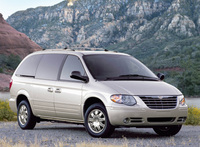2006 Dodge Caravan SXT Review and Travelogue
2006 DODGE GRAND CARAVAN SXT
A FAMILY TOUR OF THE PACIFIC NORTHWEST
By
Steve Purdy
The Auto Channel
Detroit Bureau
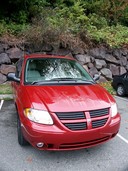 |
Four of us flew out together Wednesday morning, my pretty blonde and I along with her little brother Rick and his wife Kim. The others, other little brother Doug and his wife Julie, will join us on Saturday. These siblings tend to tease each other mercilessly so I hope they don’t distract the driver too much. Doug and Julie have been here before but the other four of us have not so the exploration will be all new and fresh for some of us.
Anticipation was building as we began our decent into SeaTac Airport when the ever-vigilant Rick spotted Mount Rainier poking dominantly out of the soft, frothy clouds. It is, of course, the icon of the area and was unmistakable.
Our Dodge Caravan was ready when we arrived and we loaded up. The SXT is a nice, well-equipped soccer-mom van with three row seating – two buckets up front, two buckets in the middle (or we might call them captain’s chairs) and a modest three-place third seat. Behind the third seat is a deep-well for cargo plenty wide enough for some big suitcases. As we’re loading our four large bags and miscellaneous smaller ones we begin to think we’ll have plenty of room for our other two guests and their stuff before we leave for Whistler on the weekend.
This is the 2006 model of the most popular people hauler – successor to the K-car-based minivan - that pioneered the genre. Dodge Caravan, by the way, is the best selling vehicle in the segment, selling about 170,000 units per year. Base price is $27,300 for the SXT and much less for the base model. We have enough options on this one to bring it up to $35,540 - lots of good stuff like the Leather Interior Group for nearly $3,000 which includes power liftgate, Infinity speakers, heated front seats, 8-way driver’s seat and 6-way passenger seat, A/C with 3-zone automatic temperature control, air filter, vehicle info system and removable front seat console. We also have the $1,000 Premium Group including adjustable pedals, rear parking assist, security alarm, 3 overhead storage bins and “touring” suspension. All three seating rows have side curtain air bags. That costs $605 extra. A six-disc CD/DVD changer with rear video costs $555 and one year of Sirius satellite radio comes in at $195. The full-on rear seat entertainment video system with 2nd row overhead 7-inch video screen, wireless headphones and remote control is $990 extra. And finally the destination charge of $730 rounds out our sticker.
After checking in to our business hotel near the airport we headed south to explore. We were looking for maps and travel tips but found a source of neither – until we scouted downtown Tacoma. At the Convention and Visitors Bureau nearly the entire staff was down the street at a convention. They left the youngest staff member, transplanted Ohioan, John the “sports guy,” to hold down the fort. He came up with some maps and offered plenty of great tips, most of which we used.
The day was waning so John advised us to visit the second largest urban park in the country - next only to Central Park in Manhattan - just a few miles from downtown Tacoma called Point Defiance, nearly 700 acres of gardens, natural areas and winding paths surrounding a zoo, an aquarium and a reconstructed fort. So we did. We were amazed at the old growth trees and the pristine wild areas as well as rose gardens and a dahlia exhibit whose colors literally jumped out at us as we rounded the bend in the park road. Rick and Kim were comfortable in the second row bucket seats but they were complaining about not being able to see out very well. The rear windows are a bit overly tinted for sight seeing and they don’t go down at all. The average sport-utility has the advantage over the average minivans in this regard – the back windows go down.
For local seafood young John recommended the restaurant in the park called Anthony’s. We had a table by the big window overlooking Commencement Bay, where the ferry to Vashon Island cruised back and forth while we four enjoyed various sea creatures fried in a wonderfully light tempura batter. Prices are moderate, portions are huge and the views are priceless. Kim is a lover of birds and animals and doesn’t miss an opportunity to feed them, so her leftover tempura went to the grateful seagulls and crows that followed us along our bayside, after-diner stroll.
To my usual question about finding local points of interest that tourists usually miss John insisted that the most not-to-miss feature in the entire area is Mount Rainier, so that’s how we spent our entire Thursday. John was right.
It seemed to take an inordinate amount of time to leave the city behind. We were on the road nearly an hour before civilization thinned. I found the door pod that houses the power window controls and power lock to be uncomfortably encroaching on my leg space. I’m a pretty big guy and my legs tend to splay when seated. If only the pod was shorter by a few inches then it would not be a problem. Otherwise, inside the Caravan is comfortable and convenient. I like the huge windshield and great visibility all around from the driver’s seat. My pretty blonde has no complaints from her side. Of course, most of the time she’s turned around in her seat chatting with her rear seat sibs.
Finally, about 15 miles from the park
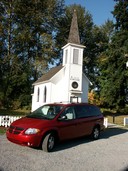 |
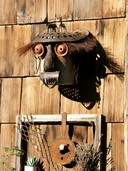 |
varied work of a sculptor and brickolage artist, Dan Klennert. Using both wood and metal Klennert has created creatures, vehicles, people and all manner of utilitarian stuff with an animated feel - some created in a remarkable scale. Most evocative is the memorial garden in back where tributes to his father and some beloved pets inspired some strange and significant works. Visitors are welcome. We enthusiastically recommend some time spent at this little-known site.
Our Caravan’s 200-hp, 3.8-liter V6 (most power available in this vehicle) is adequate for these mountain roads but another 30 or 40 hp would be nice. It has a respectable 238-lb-ft of torque to pull us up the slopes, but it still feels a bit anemic under such load as ours. Downshifts are quick enough under normal load but I still find myself downshifting often to get up the hills more expeditiously. Steering is easy and everything has a light feel. I suppose most soccer-moms are happy with that gentleness.
Because of a heavy haze we had only fleeting, foggy glances at the top of Mount Rainier on the way in. We saw it briefly poking out of the clouds from Mr. Klennert’s sculpture garden on the way into the park but the high clouds thickened and the top became obscured. We learned about the mountain’s geology and geography at the Longmire Museum interpretive center just a few miles into the park. We drove on to the Jackson visitor Center where the young ranger at the desk suggested some short trails for hiking and viewing. She also advised us that the only lunch to be had anywhere in the park was there at the grille. Having not much option and being famished we had burgers and fries – mighty pricey and pretty mediocre in quality. You might want to take a picnic lunch with you if you’re headed in there soon.
Though Rainier certainly garners lots of visitors we had the park nearly to ourselves. Our visit was essentially post-season. There was no one to complain when Kim spent an entire loaf of white bread feeding the ravens and squirrels.
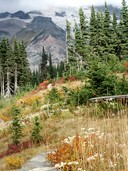 |
As we left the Paradise area to drive further into the park the fall colors were so overwhelming along the slope of Paradise Valley we had to stop and just soak them up and shoot some pictures.
Our second hike took us up the Ohanapecosh River about a mile to a site called Grove of the Patriarchs where one thousand-year-old trees hold court on an island in the river. All along the path the trees kept getting bigger and bigger until we crossed one branch of the river on a one-hiker-at-a-time suspension bridge. On the island the path is well annotated and rustic wooden benches are provided for those who just want to sit and commune with the patriarchs. If I had a nickel for every time one of us exclaimed “Wow!” today, I could retire for good.
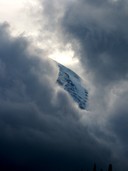 |
Downtown Seattle drew us in on three occasions during these few days in spite of the oppressive traffic on I-5 and I-405. The most visited tourist sites, the Space Needle and the Pike Place Market, compliment the generally upscale, clean and upbeat ambiance of the city. I felt like I was in San Francisco not just because of the amazingly steep east-west streets bisected by level north-south streets. The old market area and the eclectic mixture of architectural styles, the street musicians and general buzz of the city explain for me why it is such a popular place.
Our rainy day excursion took us to the Boeing assembly plant about 25 miles north of Seattle. Within the largest (by volume) building in the world three different airliners are assembled with a fourth being prepared for. The Museum of Flight there displays some fun historical stuff and lots of info on the new “787 Dreamliner,” the most modern, high-tech, fuel-efficient and shapely airplane ever built by Boeing - assembly to begin there soon.
To fill the next morning before collecting our other travelers at the airport we visited the Snoqualmie falls just 20 miles east of Seattle, twice as tall as Niagra and one-one-hundredth as wide. A steep hiking trail took us down to the river below the falls where the view was most spectacular. A brave, wet fellow was fly fishing off a big rock at the edge of the mist just a few hundred feet from the base of the falls, whipping the back-lit monofilament back and forth with amazing alacrity. What a sight.
With our new passengers, Doug and Julie, securely on board in the third seat and all their stuff stacked easily in the back we visited the Pike Place Market again indulging in some unusual fruits and watching the fish mongers toss the fish and crabs back and forth. I could barely resist the halibut cheeks displayed in a large metal bowl sunk into the ice. Julie wanted to sample everything on the fruit and veggie vendors’ tables and my pretty blonde was distracted by the massive arrays of cut flowers. By dinner time we were sitting at a table facing Puget Sound eating sea food again and quaffing some tasty Alaska Brown Ale, brother Doug’s favorite beer. We toasted our trip and the good life we have – at least for this week.
We’re packing a lot into our travel day to Whistler. We had no trouble getting all our stuff in the rear behind the third seat – six full-size suitcases and assorted bags and gear. After studying the map it looks like we can at least get a taste of the Olympic National Park then hit Highway 20 back to I-5 north of Seattle – one short ferry ride and lots of winding, scenic roads, not a lot of distance, or so it seamed by the map. It took at least 30% longer than expected but was a worth-while exploration.
My back seat passengers, now with some in the third seat, have some accolades and some criticisms of life in the Caravan’s rear after the first long day of ingress, egress and riding long distances. There is plenty of room in the third seat, even for two full-size people. Three adults abreast would be a problem for sure. The first complaint was about the lack of a grab handle to assist getting into and out of the back. There is a handle mounted on each power sliding door but it’s not in a good position to pull oneself in and out. Once in the back the headrests encroach on the passengers’ shoulders until they’re put all the way up. The steep rake of the third seat is a bit disconcerting at first. Also, in order to fold the second row seats to clear the way to the rear the headrests must be stowed in the full-low position. One extra unnecessary step, perhaps. And, of course, our new rear seat passengers complained, too, about the lack of visibility through darkened windows, again making sight-seeing a struggle. And from the driver’s perspective the vehicle is too big to allow the proper swatting of misbehaving, or fighting youngsters back there. The Zachow siblings weren’t too bad though, other than a bit of the usual bluster and bantering.
By the way, watch out for the local constabulary through the northern Olympic area. Speed limits have a way of suddenly becoming reduced where there is no logical reason for a change. On the way to the Olympic National Park I suddenly had flashing blue lights in my rearview mirror. I had been driving at a very leisurely pace on a four-lane divided, limited access road with, as it turns out, a 55-mph speed limit. Without a hint of consideration for our tourist status, lack of familiarity with the area or anything else the fast-talking young man in khaki summarily wrote us up for 5/10-over. It’ll cost me $91 he said so fast I had to ask him to slow down. He wanted to make it clear that at the 11-over he clocked me he could have written me for 10/15-over for a cost of $120. Sounds like revenue enhancement to me. Then on the way back, near the same area, we came over a hill to find ourselves facing three police cars, five officers and two radar guns pointed right at us. Welcome to Washington! A couple miles-per-hour faster over that hill, and I could have had another nice greeting card.
Our hike to Sol Duc Falls
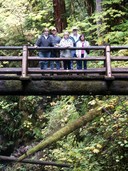 |
Finally, we got to Whistler about 11:30 and had to call the security
guy to get our key and directions to our hard-to-find condo. In the morning
 |
We got acclimated quickly and drove up the road to find the spawning salmon where we were assured there would be lots of black bears feeding on the hapless fish. We saw lots of dead and dying salmon glowing red but only one little bear cub beside the road who tried to climb a telephone pole to avoid us. Cute little guy. Rick got a good photo of him peeking around the telephone pole at us but every time I shot he hid behind the pole. All I got was a shot of his big, black paws holding on to the pole.
Even with this load of people and cargo we’re getting 19 and 20-mpg with the Caravan. EPA estimates 18-city and 25-highway so we’re pleased with this economy under load. We put a few extra pounds of pressure in the tires which probably helps. The fuel tank holds 20 gallons and when I filled, not long after the low-fuel light came on, it took 19.5. Not much margin of error there.
A day trip to Vancouver gave us the opportunity to see the Sea to Sky Highway in the daylight – from the sea at North Vancouver to the high mountains beyond our resort at Whistler – a most beautiful drive, indeed. Most dramatic is the 25 miles from North Vancouver to the end of the inlet at Squamish where the road hugs the steep, rocky cliffs on the right that plunge to the water sometimes hundreds of feet below.
In Vancouver we visited the totem collection and the Aquarium at Stanley Park where the white beluga whales and the sea otters play. We drove around town a bit, and had a late lunch at the Milestone restaurant on the waterfront. There I experienced an intense gustatory sweat eating the “spicy” Thai wrap (the first time this week that the term spicy on the menu really meant spicy). We then grabbed desert at the Purdy Chocolate store on Highway 99 just a tad south of downtown, where the little “Hedgehog” chocolates are worth the visit. On the drive back up the Sea to Sky Highway the clouds above the mountains on our left turned to a lovely soft pink. The closest we got to a colorful sunset here in the big mountains.
 |
Our week at Whistler also included a tree-top stroll where platforms, suspension bridges and boardwalks are strung through the tops of two-hundred-foot-tall Douglas fir, red cedar and hemlock trees. Kim is not fond of heights so she and Rick stayed back to wander around the shops and feed the birds. Our guide, a young man named Rob – not Bob, but Rob, he admonished us - has remarkable knowledge of the natural phenomina that created this unique ecosystem. Bob was nearly as knowledgeable as brother Doug. The valley below was created by the glacial stream of gray-green water that continues to cut deeply into the side of the mountain where these huge trees dominate. We scanned the slopes for wildlife but none presented except a few black-tail deer and lots of birds. Too bad Kim wasn’t along to feed them.
When our time was up we loaded up the van and embarked on the 4-hour drive back to SeaTac Airport in Seattle. The rain came in intermittent torrents. The Caravan served us well all week. Although handling is a bit compromised when so fully loaded we certainly can’t complain.
The Dodge Caravan earned a “Best Buy” award from Consumers Guide for being best in its class each year since 2000. While I’ve not driven all the competitors in this class I’ve driven a good number of them. There are some that handle a bit more crisply, some with more power, and some more stylish in design, but overall, I think the Best Buy award is well earned by Caravan - utility, comfort and luxury are admirable.
As for traveling with all those Zachows, I can appreciate what saints their parents must have been traveling with this clan when they were youngsters.



